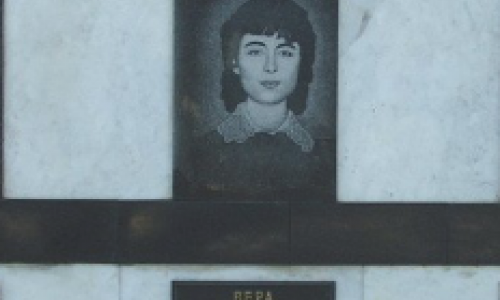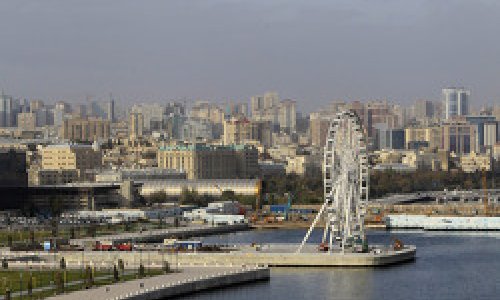by Vusala Alibayli and Famil Mahmudbeyli
The sounds of metal working roll out of the old, broken-windowed factory where reinforced concrete is made, near the Dernegul metro station on the outskirts of Baku.
Piles of broken concrete are everywhere. The cavernous structure is dark despite the patches of sunlight streaming through holes in the roof, and the air smells of oil.
It is the last place you would expect to see kids playing, mothers chatting, laundry hanging out to dry. Yet at least 100 families who fled their homes during the war with Armenia a generation ago live here – a tiny fraction of a population of Azeri refugees and internally displaced persons (IDPs) estimated by the government at an eighth of the country’s population.
"The State Committee relocated us here temporarily – for a month,” Reyhan Tagiyeva says, recalling her first days at the factory. In 1993, she fled to Baku from Kalbajar as Armenian forces captured the district. At first, she lived with her brother in a rented apartment, until they could no longer keep up the payments and turned to the State Committee for Refugee and Internally Displaced Persons’ Affairs for assistance. That was 15 years ago.
From 1988 until a cease-fire was signed in 1994, the war between Azerbaijan and Armenia over Nagorno-Karabakh – a region of Azerbaijan with a majority of ethnic Armenians – left 1.2 million Azeris homeless, according to the committee.
At first most of the fleeing Azeris moved from exposed areas to nearby safe zones, where many lived in tents. Later, the refugees and IDPs were relocated to hostels, schools, and children’s camps, but soon most came to Baku in search of better housing and ways to earn a living. For many, those hopes remain distant.
"When it rains, sometimes the lights and water don’t work. The only thing that remains is mud. It stops the children from going to school and the parents from getting to work,” Tagiyeva says, sitting at the factory entrance, where the air is fresher and the din less maddening.
A wall divides the factory into work space and living areas, but it fails to keep the noise and smoke from reaching the jerry-rigged, cardboard-walled compartments where the IDPs live.
"Every moment is dangerous for life here. A few days ago, part of the ceiling fell down on a place where people live. Who can guarantee that it won’t happen again?” Tagiyeva says. Her years here should have been the best of her life, she says. Although only 48, her hair has gone white and she has had heart surgery. Only the children here have any chance to live a good life, she says.
Those children, many with dirty faces and torn clothes, don’t seem to care that they play amid mounds of broken concrete and other waste, immersed in the noise of the factory.
"Which region are you from?” It’s not an easy question for 6-year-old Ilgar. He smiles and shrugs. The factory is the only place he’s ever known.
Most families here earn less than the average monthly income. Men typically work as laborers; women may work in bakeries or as cleaners, a few as teachers. Some families cannot send their children to school.
President Ilham Aliev approved the government’s program to improve living conditions and increase employment for IDPs and refugees in 2004. The committee that oversees the program reports that new residential complexes have been built for IDPs in the worst housing situations, including those in hostels.
The program helped improve living conditions for 230,000 refugees and IDPs in the 10 years after the program began, the committee says. Over 20 years, the state disbursed 5.1 billion manats ($4.9 billion) to improve the lives of the war’s displaced people, committee chairman and deputy prime minister, Ali Hasanov, said in 2014. Almost half of this funding, 2.3 billion manats, was provided by the state budget; the State Oil Fund contributed 2 billion manats, and the rest came from international financial institutions and humanitarian organizations.
Yet despite the oil and gas revenues that have helped Azerbaijan’s economy produce more than twice as much per person compared with its South Caucasus neighbors, hundreds of thousands still live in substandard housing, and the unluckiest live in wretched "temporary” shelters like the factory, less than half from an hour by metro from Baku’s glittering center.
"A garden, apple, pomegranate, walnut trees – I had everything on our land,” says 73-year-old Gullu Aliyeva, recalling life before the war in Shelli, a village in the Aghdam district. Part of the area now lies in Armenian-controlled Nagorno-Karabakh.
Aliyeva’s family once lived in a two-story house. Now most families in the factory have one-room compartments on the concrete floor. There is one water spigot for every five or six families. A row of full plastic water cans mutely testifies to the unreliability of the water supply.
People in the factory say they can’t remember the last time a representative of the authorities came here. "Maybe they lost our address,” someone says.
"Since 2003, more than 250,000 IDPs have been provided with apartments in residential complexes built for them,” said Avaz Hasanov, director of the Society for Humanitarian Research, a nonprofit group. "But we have to consider that the problem of housing another 300,000 IDPs is unresolved.”
"I don’t blame the government. Our government is very good. Our people are guilty,” says Leyla Sayyadova, a former resident of the Armenian-held Khojaly region. Her family of five moved from a park to an unfinished ambulance station in the Binagady district of Baku two years ago. Others moved here from tent camps and hostels in the regions as much as 10 years ago, part of a wave of displaced people who came to the capital hoping to find work.
Conditions in the unfinished building are barely better than at the concrete factory. Residents of the top floor line their ceilings with thick plastic wrap to stop rainwater from dripping. Some residents say they have seen children fatally injured in falls from the stairways.
"We are aware of the problems. But it is not currently possible to move the families now. In the future, the committee will continue its work,” said committee spokesman Elchin Gadimov.
The families are upset. As they prepare for winter, they don’t believe the committee will do anything soon. In the 12-square-meter room that is home to Sayyadova’s family, a noisy metal stove gives off heat. Gas and electricity are supplied at no charge, she says.
"Thanks to the state, we don’t pay for that. But if you come in the winter you won’t hear the sound of the heater. The gas flow slows down, and it will be freezing inside and out,” she says, wrapping her arms around her 2-year-old daughter.
The displaced and many other Azeris wonder why the state neglected more than 1 million people for so long after the Armenian war was suspended in 1994.
"The government was not interested in integrating IDPs into society for a long time and wanted to gain international support to push for a solution to the Nagorno-Karabakh conflict by showing the miserable social situation of IDPs,” Hasanov said. "Then they saw that this was not effective.”
Then oil revenues began flowing in as the country developed its huge offshore hydrocarbon deposits.
"As oil income rose, international organizations started to criticize Azerbaijan for not closing the tent camps. Finally, the state did start to improve these people’s living conditions,” Hasanov said.
But the government seems to have a policy against full integration of the displaced people in an Azerbaijan shorn of Karabakh and surrounding territory.
"Full integration would lessen [the public’s] belief in the liberation of these lands,” he said.
"Those who are silent don’t get resettled,” Sayyadova says. People in her building claim money can buy a place on the resettlement list, something Gadimov denies.
"There is not even a word about money. The committee makes a list of families who have to be resettled, and our representatives see that it happens,” Gadimov said.
"I don’t think the committee has a serious procedure for rehousing IDPs,” Hasanov said. He thinks the government should be more flexible. "They should conduct a census of people who regularly live in bad conditions and provide [permanent] housing depending on the severity of their condition.”
Karim Karimli, a journalist and an IDP from Shusha, a historic city in Karabakh that fell to Armenian forces in 1992, is skeptical of the government’s commitment to rehousing the displaced in satisfactory conditions. At the same time, he is fiercely patriotic.
"Even if a million refugees and IDPs could live in the best conditions here in Baku, it doesn’t mean we will consent to the occupation of our lands. No, never. Let’s say we don’t return, but Azerbaijan will never give our territory to the enemy,” he insisted.
One reason behind the stop-start progress of the state IDP rehousing program is what Karimli calls "huge projects costing plenty of money.”
"For instance, recently the country held the European Games. On the eve of this project, IDP rehousing broke off. But when the games were over, the process got moving again,” he said.
A short walk from the ambulance building at a hostel for IDPs near the grandiose new Heydar Mosque, people are in a hurry, collecting their belongings. They are not eager to talk, perhaps afraid they might miss their chance to get a permanent home. Their turn to move into one of the new residential complexes has finally come. Why they have been chosen over the residents of the concrete factory or the crumbling ambulance station is a question that may never be answered.
(Transitions Online)
(Transitions Online)
www.ann.az
Follow us !








